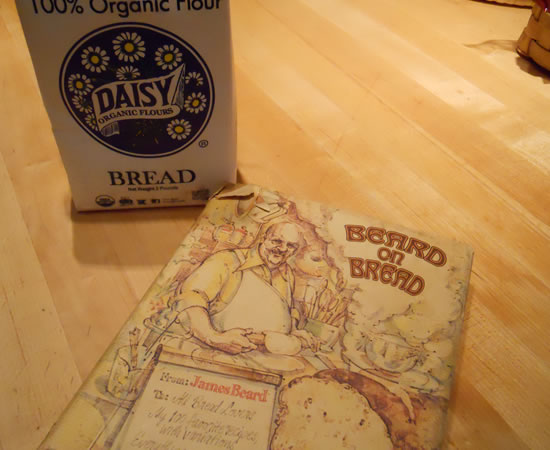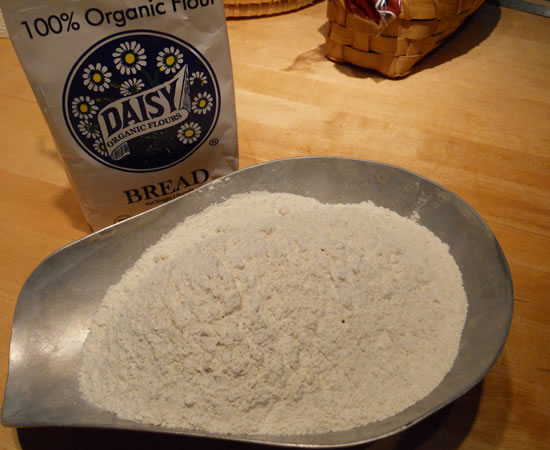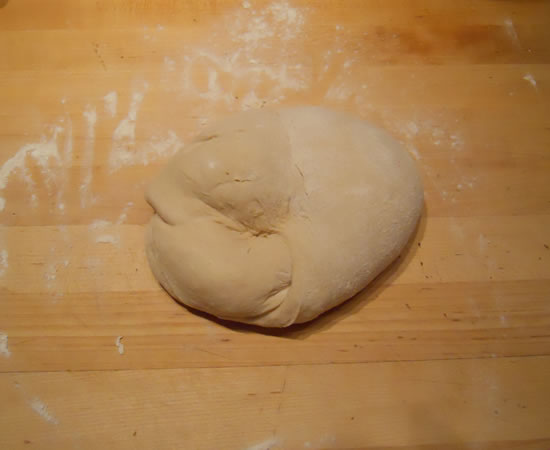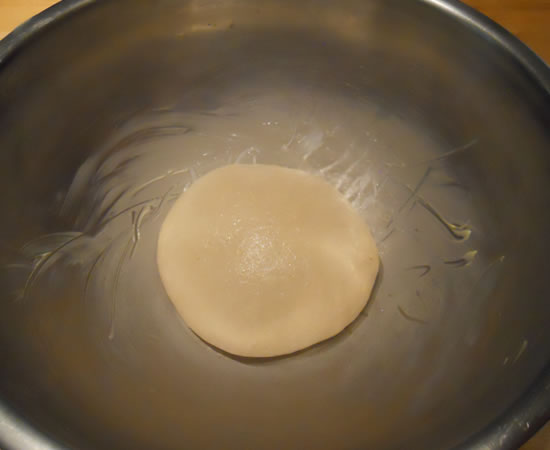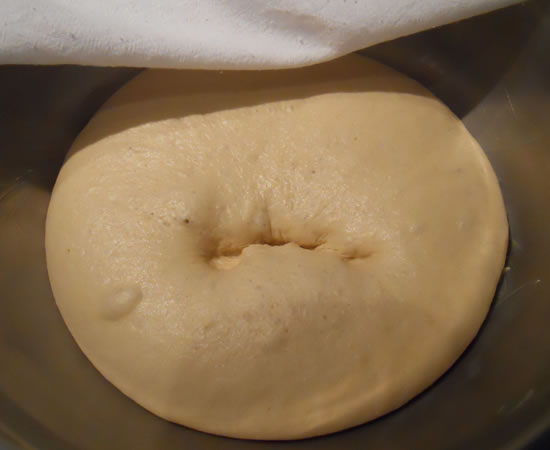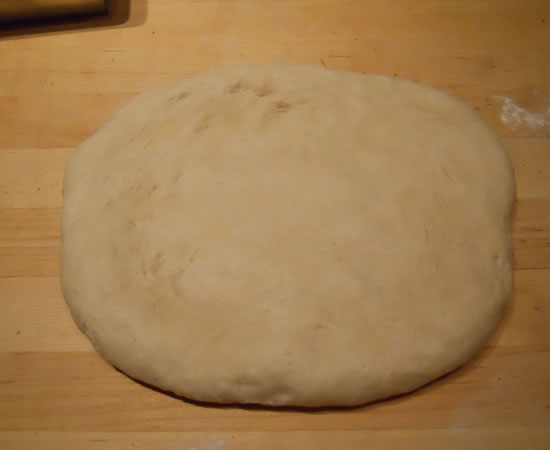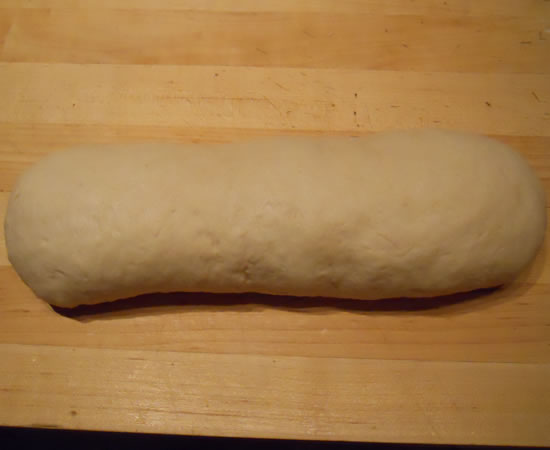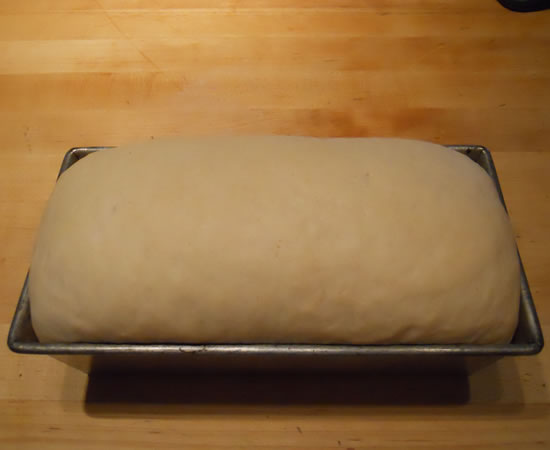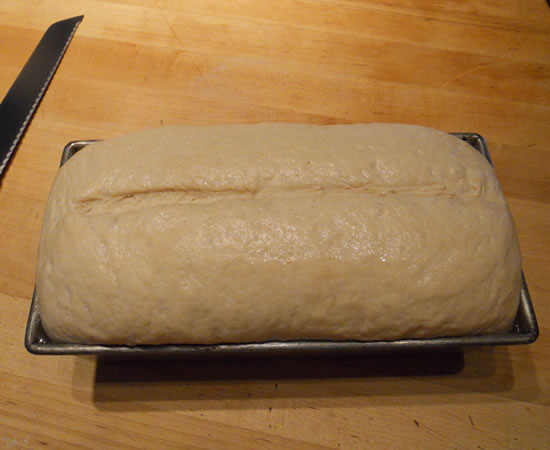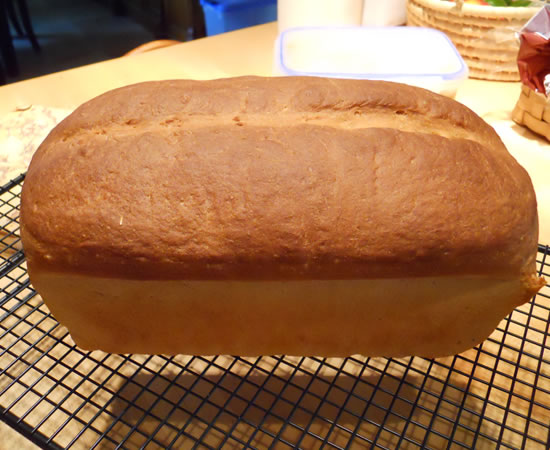When the Daisy flour arrived last week I knew I was going to have some fun with it.
Baking and I go well together. I love homemade breads, pastries, cakes, cookies, pies… All that good stuff. And if you’re going to take the time to do it – use quality ingredients and make the time to do it right.
Coming up with my first loaf of bread, though, presented a bit of a challenge. My first instinct was to make an artisan-type bread. Something rustic and crusty (kinda like me.) In the end, though, I thought a classic white loaf was really where I should begin – and that meant James Beard.
James Beard has been my culinary hero since day two. (Julia Child came first.) I love the introduction to his 1959 cook book – a recipe for boiling water. He taught the basics and then used them to build more complex recipes. In his 1973 Beard on Bread, he demystified bread-making for a generation that was raised on Wonder Bread.
It was to this tome I turned for my first loaf. I’ve made the Basic White Bread many times. It really is a quick and easy loaf and pretty foolproof. As with most of Beard’s recipes, you really have to work at screwing it up.
The recipe below is verbatim from the 1973 cook book. It is long and detailed as his instructional recipes generally are. His subsequent recipes assume the reader has read and understands the basics and he does not repeat himself. The beauty of his cook books and recipes is that he actually explains why something happens and how to compensate for the variables of things such as weather and ingredients. Anyone can cook if they pay attention.
Basic White Bread
This is my idea of a good, simple loaf of bread—firm, honest in flavor, tender to the bite yet with a slight chewiness in the crust, and excellent for toast. The ingredients are just flour, water, salt, and yeast, with the addition of a little sugar. It is a recipe I use constantly, although I vary it from time to time, and I have chosen it as my first recipe here because I think it will provide any beginner with the basic techniques of breadmaking. In fact, it is one I have taught to my pupils through the years. Once you have mastered the procedures given here, you can go on to more complex recipes without difficulty.
As I have said in the introductory observations, there are many variables in breadmaking. As far as flours are concerned, for example, since I know that the hard wheat flour producing the best results in wheat breads is not always easy to come by, in this recipe we’ll use a common unbleached (or bleached) all-purpose flour. And since compressed yeast is often difficult to find and the dry variety is available everywhere, throughout this book we’ll use “active dry yeast” and refer to the measure by package, although occasionally I will suggest the alternative of compressed yeast, since many people enjoy working with it. Some breads call for milk or fruit juice; some, like this one, are made with water. The salt content of bread is adjustable too: I use a rule of thumb of 1 tablespoon for each pound (3¾ cups) of flour; you may alter this to your own taste. There are several ways to knead dough, several ways to shape it into a loaf, and it can be given one or more risings. There is also a choice of washes you can use on the loaf before it goes into the oven, and you can slash the top in different styles or leave it as it is. Even the weather has an effect on breadmaking. The degree of humidity and warmth will govern the absorption quality of the flour and the action of the yeast.
Here, in this first recipe, we’ll reduce decisions to a minimum and put all of these extra factors into footnotes. You should be able to make this loaf successfully the first time around without referring to a single one of the notes. But they will come in handy as you vary ingredients and develop your own style of baking. For instance, if you have small hands, you will probably prefer to use two hands for kneading. The approach to making every loaf of bread is essentially the same, and for that reason you should implicitly have this recipe in mind throughout the rest of the book, as I will not keep spelling out fundamental procedures, such as how to proof or how to knead.
Yield : 1 large loaf or two smaller loaves
Ingredients
- 1 package active dry yeast
- 1½ to 2 cups warm water (l00° to 115°, approximately)
- 2 teaspoons granulated sugar
- 3¾ to 4 cups all-purpose flour (approximately 1 pound)
- 1 tablespoon salt
- 1½ to 2 tablespoons softened butter for buttering bowl and pan
Directions
First, proof the yeast, which means testing it to make sure it is still active. To do this, pour the contents of the package into ½ cup of the warm water (about 100° to 115°), add the sugar, stir well, and set aside. After a few minutes the fermentation of the yeast will become apparent as the mixture swells and small bubbles appear here and there on the surface.
1. While the yeast is proofing, measure 3¾ cups unsifted flour into a 2- to 3-quart bowl with rounded sides. (Save the other ¼ cup flour for kneading, if necessary.) Add the tablespoon of salt and blend well.
2. Pour approximately ¾ cup warm waters into the flour and stir it in with a wooden spoon or with your hands. Add the yeast mixture, and continue stirring until the ingredients are thoroughly blended and tend to form a ball that breaks away from the sides of the bowl. (If the dough is very stiff, add a tiny bit more water.) Transfer the dough to a lightly floured marble slab, bread board, or counter top.
3. Now begin the kneading process, which evenly distributes the fermenting yeast cells through the dough. There are several ways to knead,4 but I prefer this one-handed method: Sprinkle the dough lightly with flour and also flour your working hand. Push the heel of your hand down into the dough and away from you. Fold the dough over, give it a quarter turn, and push again with the hand. Continue the sequence of pushing, folding, and turning until it becomes a rhythmic motion. Knead until the dough no longer feels sticky and has a smooth, satiny, elastic texture, adding more flour, if necessary; this will take anywhere from 4 to 10 minutes, depending on the character of the flour and the warmth and humidity of the room. To test whether the dough has been kneaded enough, make an indentation in it with your fingers; it should spring back. Sometimes blisters will form on the surface of the dough and break, which is another sign that the kneading is sufficient.
4. When the dough has reached the consistency described above—with experience you will know what this means by the feel of it—it is ready for the first rising. (Rising allows the fermenting yeast to produce tiny bubbles of carbon dioxide, which stretches the gluten in the flour and thus leavens the bread.) First, rest the dough on the board for several minutes. Meanwhile, wash out the mixing bowl; dry it, and rub it with 1 to l½ tablespoons of softened butter.
5. Place the ball of dough in the bowl, and roll it around so that it becomes completely coated with butter. (This will keep the surface from drying out and cracking as the dough rises.) Cover the bowl with a piece of plastic wrap or foil or with a towel and set in a warm, draft-free place. (The term “draft-free,” which you will encounter repeatedly, is used because the yeast must be pampered with constant warmth to keep it active.) Find a protected corner or shelf, or use a cool oven (it won’t hurt if the pilot light is on). Allow the dough to double in bulk, which will take about 1 to 2 hours.
It is difficult for a beginner to tell when dough has actually doubled in volume, but the increase is dramatically more than one might expect. You can get the idea best by pouring 4 cups of water into the empty bowl (before it has been greased) and then pouring in the same amount again, noting how high up the water comes. Fortunately there is another, surer test to show when the dough is properly risen. When it looks ready, simply make an indentation in it with two fingers. If the dough does not spring back, then it is ready. It will not hurt should it rise a little too much, but excessive rising will affect the flavor and texture of the finished bread. If for some reason you must prolong a rising, place the bowl of dough in the refrigerator to slow down the action of the yeast.
The dough must now undergo a second rising, which will take place in the baking pan. Thoroughly butter one or two heavily tinned loaf pans.
6. Then remove the cover from the bowl and deflate the dough by pushing down into it with your fist. Transfer it to a floured board, knead it rather well for about 3 minutes, then pat it into a smooth round or oval shape. Let it rest for 4 to 5 minutes, then form it into a loaf about 8 inches long and 3 inches wide.
7. Lift it carefully, drop it into the loaf pan, and smooth it out.Cover the loaf pan, as you did the bowl, and set it in a warm, draft-free place to double in bulk, at which point the loaf will have risen slightly above the edge of the pan. The second rising will take anywhere from 40 minutes to 1¼ hours, according to the warmth of the room and the way you have worked the dough. Don’t rush the process, and watch the dough carefully. Meanwhile, set the oven for 400°.
8. There are various ways to treat the loaf before it goes into the oven. For this recipe, merely brush the dough with cold water, which helps to give the top a textured crust.
9 Then, with a sharp knife make three diagonal slashes about ½ inch deep across the top of the loaf, both for a more professional look and to prevent cracking.
10 Place the pan near the center of the lower oven rack and set a timer for 35 minutes. Begin testing after that time, even though the total baking time may be as much as 50 minutes. To test, rap the top of the loaf with your knuckles. When done, it will sound hollow. Invert the loaf onto a towel held in one hand and test the bottom as well for that hollow sound. If it does not seem quite firm enough and needs only a little more baking, place the loaf directly on the oven rack to crisp the bottom, watching it carefully to prevent it from burning. If the test shows that the bottom is somewhat soft, slide the loaf back into the heated pan and return it to the oven to bake for 5 or 6 minutes more. Test the bottom again, and when firm enough, bake the unmolded loaf a few minutes for the final crisping. When completely baked, remove from the oven and set on a bread rack to cool.
After 2 or 3 hours the bread is good for slicing. When it is thoroughly cooled it can be stored in a plastic bag, in or out of the refrigerator, for several days. It also freezes well, and a frozen loaf, wrapped airtight, can be stored for a month. To reheat, remove from the freezer, wrap in aluminum foil, and heat in a 350° oven for about 20 to 40 minutes.
VARIATION
Whole-Wheat Bread: This same recipe can be used to make a whole-wheat loaf. Merely use 2 cups whole-wheat flour and 1¾ to 2 cups white flour. For a slightly richer loaf, add 3 to 4 tablespoons olive oil or peanut oil to the flour before adding the water, and use slightly less water to compensate for the oil.
Notes
1. If you use compressed yeast, crumble it into a measuring cup, add the sugar, and cream the two ingredients together with a spoon for a minute or two, until the mixture becomes quite soft and runny; this helps activate the yeast. Add the warm water–in this instance no warmer than 95°.
2. I feel that 1 tablespoon of salt to 1 pound of flour is the right seasoning, but some people feel it is too much. You can increase or decrease the amount according to your taste. (A sweet bread, for instance, may not take as much.)
3. Milk can be used instead of water; it makes a somewhat richer bread.
4. Here are three alternative ways to knead:
A. Push into the dough with the heel of your right hand (if you are right-handed), then fold the dough toward you, at the same time giving the mass a quarter turn with your left hand, pulling it toward you; this is one continuous circular motion. Repeat the procedure, increasing your speed. It sounds complicated but is in fact quite simple and fast; and it gives a better fold.
B. Many people prefer to knead with both hands. In this procedure you push into the dough with the heels of the hands, fold the dough over, and give it a quarter turn before pushing again.
C. You can use the dough hook in the electric mixer; see description on page 10.
5. You can also use vegetable oil.
6. You can also use aluminum, aluminum foil, stainless steel, or glass.
7. Here are two alternative ways to shape a loaf:
A. Pat or roll the dough into a strip about as wide as the bottom of the loaf pan and approximately three times the length of the pan. Lightly mark the dough into thirds or just visualize the divisions. Fold the first third over the middle third, and pinch the edges together very well. Fold the final third over the other two thirds, again pinching the edges together. Then with both hands plump the loaf and fit it into the buttered pan.
B. Roll out the dough, and then roll it up into a sausage shape. Tuck the ends under and fit it, seam side down, in the buttered pan.
8. When using glass for baking, always set the temperature 25 degrees lower than is specified, since glass heats faster than metal and holds the heat longer.
9. The dough can also be brushed with a mixture of lightly beaten egg whites and water, which colors the crust and makes it very crisp, or it can be brushed with a mixture of beaten egg yolk and milk, cream, or water, which gives the crust a rich brown color.
10. The loaf can also be slashed lengthwise down the center.
REMEDIES FOR THE NOT-QUITE-PERFECT SLICE
- If your slice sags more than the one on the next page and is soggy to the bite, the dough was not aerated enough. It probably had too much liquid and did not get enough kneading. Next time work in a bit more flour as you knead and keep at it longer.
- If your dough seems to have a pretty good crumb but tastes damp, it means that it did not bake long enough. Try putting it in the oven at a slightly lower temperature at the start and let it cook longer.
- If your loaf has really fallen flat and doughy, gooey streaks appear in the slices, the chances are that the second rising was too long and the bread collapsed on contact with the heat. Be careful not to let the loaves rise too much in the pans.
- If your bread has risen more on one side than on the other, you probably had it in the wrong position in the oven. And if the slice has an uneven crumb, this is certainly true. Next time be sure to place a single loaf in the center of the oven so that uneven distribution of heat won’t upset the form and shape of the loaf while it is baking. Usually, if you have several loaves in the oven, evenly spaced, this problem will not occur, since the flow of air around the pans will be regular.
- If your loaf has cracked on one side during the baking, don’t worry. It is likely to be a perfectly good loaf–in fact, it may be utterly delicious–even if it doesn’t look beautiful. This is something that at times even the best bakers can’t prevent.
- If the bottom and side crusts are pale and soft and the bread is difficult to slice without having to saw with a very sharp knife, next time remove the bread from the pan and place it on the rack or on tiles in the warm oven to brown and crisp the bottom and sides, turning the loaves once, before cooling. (Also, do not ever wrap loaves in plastic before they are thoroughly cooled.)
- If your bread has really mushroomed and there is a rather deep indentation around the bottom, it means that the entire loaf has broken away from the bottom crust, probably because you tried to pack too much dough into too small a pan, or, if you were making a free-form loaf, your oven was undoubtedly too hot at first so that the bottom cooked too quickly and as the loaf rose it broke away and mushroomed. In either case you’ll have an uneven slice, denser at the bottom than at the top, but this is no great tragedy.
- If your free-form loaf spread too much as it was rising, your dough was too soft. Free-form loaves must be quite firm when shaped. Next time remember to add extra flour as you are kneading and if you are still uncertain put the dough in a ring to contain it.
- If, when slicing your bread, you find that the top crust separates from the rest, it means your loaf was not properly formed and the heat caused instant aeration when it was put in the oven. This is not a serious matter and sometimes happens even with commercial breads. To remedy, try one of the alternate methods of forming to get a tighter loaf.
- Large holes in your bread indicate that you may have overkneaded or that the dough rose too long. This is an advantage with certain freeform loaves, particularly French, but with other breads an even crumb is one of the attributes of good baking. All this is really a matter of taste, however, and if you really like a strong bread with big holes and a chewy texture, given the dough lots of kneading and a long, slow rise–even two risings.
- If there are circular streaks in your slice, don’t worry. They are usually caused by the rolling and pinching of the dough when you formed your loaf, and you probably pinched too vigorously.
- If your slice has doughy or small, hard lumps, it is certain that the original dough was not mixed sufficiently, possibly because it got too stiff to handle. Next time hold back on the flour so that the dough gets thoroughly mixed, then work in additional flour as you knead.
The recipe calls for 3 3/4 to 4 cups of flour – or 1 pound. Weights are more accurate than cups, so if you have a scale, use it!
I use a KitchenAid mixer to make the dough but always finish it off by hand. All of the precise measurements in the world cannot compete with your hands for knowing exactly when the dough is ready.
Place in a well-buttered bowl and roll the dough around to cover it completely with a butter film. This keeps the dough from drying out and forming a tough skin.
Let the dough rise until it is double in bulk and when your fingers pressed into the dough leave an impression.
Pat the dough out to the size of your pan. Starting at the top, roll it towards you with the heels of your hands, pinching and sealing it as you go.
Place formed loaf into buttered pan and cover for second rise.
After second rise.
Brush loaf with water and slit top. Three width-wise cuts or one lengthwise cut will work. Bake..
Let cool and then enjoy…
And enjoy, we did!
Hands-down one of the best loaves of plain ol’ sandwich bread I’ve ever made! A perfect crust and a perfect crumb. Soft, but with substance. Out-of-this-world-goodness!
So, you ask… is it the flour or is it the recipe?
And the answer is both, of course. A perfect flour with a mediocre recipe will result in a mediocre product. The same holds true with the flour – mediocre flour will produce a mediocre product no matter how fantastic the recipe.
So thank you, James Beard, and thank you, Daisy Flour.
I have a feeling I’m going to be making a lot of this.
It’s perfect.


